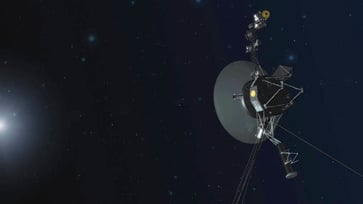NASA reconnects with Voyager 1 spacecraft after decades using obsolete technology.
In 1977, Voyager 1 and Voyager 2 embarked on a journey to explore the gas giant planets in our solar system.

NASA reconnected with Voyager 1, a spacecraft located 15 billion miles away from Earth, using a frequency not used in over forty years.
NASA's Jet Propulsion Laboratory in Southern California has experienced intermittent communication with Voyager 1, with the spacecraft ceasing to send readable data on November 14, 2023, and not resuming communication until April.
Recently, the spacecraft shut down one of its transmitters due to suspected fault protection system activation, triggered by an issue onboard Voyager 1.
NASA explained that if the spacecraft's power supply is depleted, fault protection will activate to conserve energy by shutting down non-essential systems.

On Oct. 16, the spacecraft's heaters were activated by the flight team, with the command taking 23 hours to travel from Earth and another 23 hours for the data to return.
Despite the fault protection system being triggered, engineers believed that Voyager 1 should have had enough power to operate the heather.
Due to the Deep Space Network's inability to detect Voyager 1's signal on Oct. 18, the team discovered an issue. The X-band radio transmitter, which is used for communication between NASA and the spacecraft, operates on a specific frequency.

Engineers discovered that the fault protection system reduced the rate at which the transmitter sent data back to NASA, resulting in a change in the X-band signal that the Deep Space Network needed to listen for.
After locating the signal, the team discovered that Voyager 1 was stable and started investigating the cause.
On Oct. 19, Voyager 1 stopped communicating with the team entirely.
The team suspected that Voyager 1's fault protection system was activated twice more, prompting it to switch to a secondary radio transmitter known as the S-band, which consumes less energy.

Voyager 1 had not used the S-band to communicate with Earth since 1981.
The Deep Space Network engineers were able to detect the spacecraft's communication from the S-band, and to avoid turning on the X-band before determining the cause of the fault protection system trigger, they sent a command on Oct. 22 to confirm the S-band transmitter's functionality.
The team is currently focused on collecting data to determine the cause of Voyager 1's malfunction and restore it to normal operation.
The journey of Voyager 1 commenced in 1977 with the launch of the spacecraft and its sibling, Voyager 2, for an exploration of the gas giant planets in the solar system.
Voyager 2 viewed stunning images of Jupiter's giant red spot and Saturn's rings before moving on to Uranus and Neptune. Meanwhile, Voyager 1 utilized Saturn's gravitational pull to propel itself beyond Pluto.
science
You might also like
- Lunar modules from the first two moon landings have been captured in stunning detail by Orbiter photos, more than 50 years after the historic missions.
- Discovery of a remarkable mastodon jaw in a New York homeowner's backyard
- NASA resumes communication with Interstellar Voyager 1 after pause.
- In 2055, the asteroid that was once referred to as Earth's "mini moon" will make a return visit.
- A new species of sea slug that resides in the ocean's 'midnight zone' has been discovered with a glowing appearance.



















